Dell 4300s, 6K797 User Manual
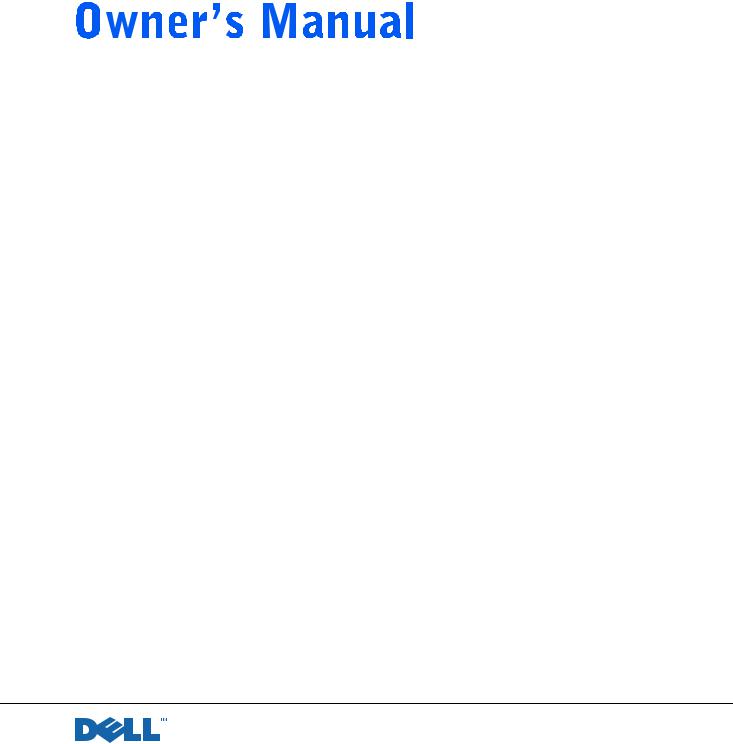
Dell™ Dimension™ 4300S
w w w . d e l l . c o m | s u p p o r t . d e l l . c o m
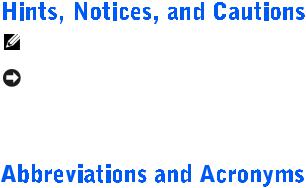
HINT: A HINT indicates important information that helps you make better use of your computer.
NOTICE: A NOTICE indicates either potential damage to hardware or loss of data and tells you how to avoid the problem.
 CAUTION: A CAUTION indicates a potential for property damage, personal injury, or death.
CAUTION: A CAUTION indicates a potential for property damage, personal injury, or death.
For a complete list of abbreviations and acronyms, see the Tell Me How help file. To access help files, see page 28.
____________________
Information in this document is subject to change without notice. © 2001 Dell Computer Corporation. All rights reserved.
Reproduction in any manner whatsoever without the written permission of Dell Computer Corporation is strictly forbidden.
Trademarks used in this text: Dell, the DELL logo, Dimension, Inspiron, Latitude, OptiPlex, Dell Precision, DellPlus, and DellNet are trademarks of Dell Computer Corporation; Intel and Pentium are registered trademarks of Intel Corporation; Microsoft and Windows are registered trademarks of Microsoft Corporation.
Other trademarks and trade names may be used in this document to refer to either the entities claiming the marks and names or their products. Dell Computer Corporation disclaims any proprietary interest in trademarks and trade names other than its own.
This product incorporates copyright protection technology that is protected by method claims of certain U.S. patents and other intellectual property rights owned by Macrovision Corporation and other rights owners. Use of this copyright protection technology must be authorized by Macrovision Corporation, and is intended for home and other limited viewing uses only unless otherwise authorized by Macrovision Corporation. Reverse engineering or disassembly is prohibited.
October 2001 |
P/N 6K797 |
Rev. A00 |

|
Safety Instructions . . . . . . . . . . . . . . . . . . . . . . . . . |
9 |
|
When Using Your Computer . . . . . . . . . . . . . . . . . . . |
9 |
|
Ergonomic Computing Habits . . . . . . . . . . . . . . . . . . |
10 |
|
When Working Inside Your Computer . . . . . . . . . . . . . . |
12 |
|
Protecting Against Electrostatic Discharge . . . . . . . . . . . |
13 |
1 |
Setting Up |
|
|
Attaching and Removing the Computer Stand . . . . . . . . . . . |
16 |
|
Connecting a Printer . . . . . . . . . . . . . . . . . . . . . . . . |
18 |
|
Parallel Printer . . . . . . . . . . . . . . . . . . . . . . . . . |
18 |
|
USB Printer . . . . . . . . . . . . . . . . . . . . . . . . . . |
20 |
|
Installing the Printer Driver . . . . . . . . . . . . . . . . . . . |
20 |
|
Transferring Information to a New Computer |
|
|
(Windows XP only) . . . . . . . . . . . . . . . . . . . . . . . . . |
21 |
|
Setting Up a Home and Office Network |
|
|
(Windows XP only) . . . . . . . . . . . . . . . . . . . . . . . . . |
22 |
|
Turning Off the Computer . . . . . . . . . . . . . . . . . . . . . |
22 |
|
Windows XP . . . . . . . . . . . . . . . . . . . . . . . . . . |
22 |
|
Windows 2000 . . . . . . . . . . . . . . . . . . . . . . . . . |
22 |
2 |
Solving Problems |
|
|
Finding Solutions . . . . . . . . . . . . . . . . . . . . . . . . . . |
26 |
|
Accessing Help Files . . . . . . . . . . . . . . . . . . . . . . . . |
28 |
|
Power Problems . . . . . . . . . . . . . . . . . . . . . . . . . . . |
28 |
Contents 3

Start-Up Error Messages . . . . . . . . . . . . . . . . . . . . . |
29 |
Video and Monitor Problems . . . . . . . . . . . . . . . . . . . |
30 |
If the screen is blank . . . . . . . . . . . . . . . . . . . . . . |
30 |
If the screen is difficult to read . . . . . . . . . . . . . . . . . |
31 |
Sound and Speaker Problems . . . . . . . . . . . . . . . . . . . |
32 |
Printer Problems . . . . . . . . . . . . . . . . . . . . . . . . . |
33 |
If you cannot print to a parallel port printer . . . . . . . . . . |
33 |
If you cannot print to a USB printer . . . . . . . . . . . . . . |
34 |
Scanner Problems . . . . . . . . . . . . . . . . . . . . . . . . . |
35 |
Modem Problems . . . . . . . . . . . . . . . . . . . . . . . . . |
36 |
Mouse Problems . . . . . . . . . . . . . . . . . . . . . . . . . . |
37 |
Keyboard Problems . . . . . . . . . . . . . . . . . . . . . . . . |
38 |
Drive Problems . . . . . . . . . . . . . . . . . . . . . . . . . . |
39 |
If you cannot save a file to a floppy disk . . . . . . . . . . . . |
39 |
If you cannot play a music CD or install a program |
|
from a CD . . . . . . . . . . . . . . . . . . . . . . . . . . . |
40 |
If you cannot play a DVD movie . . . . . . . . . . . . . . . . |
40 |
If the CD-RW drive stops writing . . . . . . . . . . . . . . . . |
41 |
If you have a hard drive problem . . . . . . . . . . . . . . . . |
41 |
Network Problems . . . . . . . . . . . . . . . . . . . . . . . . . |
42 |
Microsoft® Windows® Error Messages . . . . . . . . . . . . . . |
42 |
General Program Problems . . . . . . . . . . . . . . . . . . . . |
43 |
A program crashes . . . . . . . . . . . . . . . . . . . . . . . |
43 |
A program stops responding . . . . . . . . . . . . . . . . . . |
44 |
A program error causes the system to lock up . . . . . . . . . |
44 |
A solid blue screen appears . . . . . . . . . . . . . . . . . . |
44 |
A program is designed for an earlier Windows |
|
operating system . . . . . . . . . . . . . . . . . . . . . . . . |
45 |
4 Contents

Internet Connection Problems . . . . . . . . . . . . . . . . . . . |
45 |
If you have a problem with your Internet connection . . . . . . . |
45 |
E-Mail Problems . . . . . . . . . . . . . . . . . . . . . . . . . . |
46 |
Resolving Other Technical Problems . . . . . . . . . . . . . . . . |
47 |
Reinstalling Drivers . . . . . . . . . . . . . . . . . . . . . . . . . |
47 |
Using the Windows XP Device Driver Rollback . . . . . . . . . |
49 |
Resolving Software and Hardware Incompatibilities . . . . . . . |
50 |
Windows XP . . . . . . . . . . . . . . . . . . . . . . . . . . |
50 |
Windows 2000 . . . . . . . . . . . . . . . . . . . . . . . . . |
51 |
Using System Restore . . . . . . . . . . . . . . . . . . . . . . . |
52 |
Creating a Restore Point . . . . . . . . . . . . . . . . . . . . |
53 |
Restoring the Computer to an Earlier Operating State . . . . . . 54 |
|
Undoing the Last System Restore . . . . . . . . . . . . . . . . |
55 |
Reinstalling Windows XP . . . . . . . . . . . . . . . . . . . . . . |
55 |
Reinstalling Windows 2000 . . . . . . . . . . . . . . . . . . . . |
57 |
3 Adding Parts
Front and Back View of the Computer . . . . . . . . . . . . . . . |
60 |
Opening the Computer Cover . . . . . . . . . . . . . . . . . . . |
61 |
Looking Inside Your Computer . . . . . . . . . . . . . . . . . . . |
63 |
System Board . . . . . . . . . . . . . . . . . . . . . . . . . . |
64 |
Adding Cards . . . . . . . . . . . . . . . . . . . . . . . . . . . . |
65 |
Adding Memory . . . . . . . . . . . . . . . . . . . . . . . . . . . |
69 |
Closing the Computer Cover . . . . . . . . . . . . . . . . . . . . |
71 |
Contents 5

4 Appendix
Specifications . . . . . . . . . . . . . . . . . . . . . . . . . . . |
74 |
Standard Settings . . . . . . . . . . . . . . . . . . . . . . . . . |
78 |
Viewing Settings . . . . . . . . . . . . . . . . . . . . . . . . |
79 |
System Setup Program Screens . . . . . . . . . . . . . . . . |
79 |
Clearing Forgotten Passwords . . . . . . . . . . . . . . . . . . . |
80 |
Replacing the Battery . . . . . . . . . . . . . . . . . . . . . . . |
81 |
Dell Technical Support Policy (U.S. Only) . . . . . . . . . . . . |
82 |
Definition of "Dell-Installed" Software and Peripherals . . . . . |
83 |
Definition of "Third-Party" Software and Peripherals . . . . . . |
83 |
Contacting Dell . . . . . . . . . . . . . . . . . . . . . . . . . . |
84 |
Contact Numbers and Addresses . . . . . . . . . . . . . . . . |
84 |
Returning Items for Warranty Repair or Credit . . . . . . . . . |
98 |
Regulatory Information . . . . . . . . . . . . . . . . . . . . . . |
98 |
FCC Notices (U.S. Only) . . . . . . . . . . . . . . . . . . . . |
100 |
Battery Disposal . . . . . . . . . . . . . . . . . . . . . . . . |
102 |
NOM Information (Mexico Only) . . . . . . . . . . . . . . . . |
103 |
Información para NOM (únicamente para México) . . . . . . . |
104 |
Limited Warranties and Return Policy . . . . . . . . . . . . . . |
105 |
One-Year Limited Warranty (U.S. Only) . . . . . . . . . . . . |
105 |
Two-Year Limited Warranty (U.S. Only) . . . . . . . . . . . . |
107 |
Three-Year Limited Warranty (U.S. Only) . . . . . . . . . . . |
111 |
Four-Year Limited Warranty (U.S. Only) . . . . . . . . . . . . |
114 |
One-Year Limited Warranty (Canada Only) . . . . . . . . . . . |
117 |
Two-Year Limited Warranty (Canada Only) . . . . . . . . . . . |
119 |
Three-Year Limited Warranty (Canada Only) . . . . . . . . . . |
122 |
6 Contents

"Total Satisfaction" Return Policy
(U.S. and Canada Only) . . . . . . . . . . . . . . . . . . . . 126
One-Year End-User Manufacturer Guarantee
(Latin America and the Caribbean Only) . . . . . . . . . . . . 127
Index . . . . . . . . . . . . . . . . . . . . . . . . . . . . . . . . . . 129
Contents 7

8 Contents
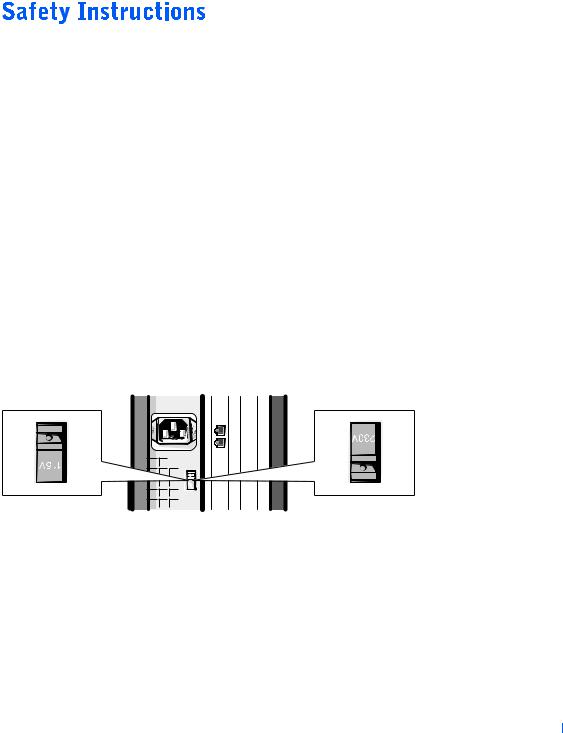
Use the following safety guidelines to protect yourself and your computer.
When Using Your Computer
 CAUTION: Do not operate your computer with any cover(s) (including the computer cover, filler brackets, front-panel inserts, and so on) removed or opened.
CAUTION: Do not operate your computer with any cover(s) (including the computer cover, filler brackets, front-panel inserts, and so on) removed or opened.
•Your computer is equipped with either an auto-sensing voltage selector or a manual voltage-selection switch. Computers with an auto-sensing voltage selector do not have a voltage-selection switch on the back panel and automatically detect the correct operating voltage. Computers with a voltage-selection switch on the back panel must be manually set to operate at the correct operating voltage. To help avoid damaging a computer with a manual voltage-selection switch, be sure that the voltage-selection switch is set to match the AC power available at your location:
–115 V/60 Hz in most of North and South America and some Far Eastern countries such as South Korea and Taiwan
–100 V/50 Hz in eastern Japan and 100 V/60 Hz in western Japan
–230 V/50 Hz in most of Europe, the Middle East, and the Far East
Also be sure that your monitor and attached devices are electrically rated to operate with the AC power available in your location.
•To avoid shorting out your computer when disconnecting a network cable, first unplug the cable from the network adapter on the back of your computer, and then from the network jack. When reconnecting a network cable to your computer, first plug the cable into the network jack, and then into the network adapter.
9

w w w . d e l l . c o m | s u p p o r t . d e l l . c o m
•To help avoid possible damage to the system board, wait 5 seconds after turning off the computer before disconnecting or connecting a non-USB device from the computer.
•To help prevent electric shock, plug the computer and device power cables into properly grounded power sources. These cables are equipped with 3-prong plugs to help ensure proper grounding. Do not use adapter plugs or remove the grounding prong from a cable. If you must use an extension cable, use a 3-wire cable with properly grounded plugs.
•To help protect your computer from sudden, transient increases and decreases in electrical power, use a surge suppressor, line conditioner, or uninterruptible power supply.
•Be sure that nothing rests on your computer’s cables and that the cables are not located where they can be stepped on or tripped over.
•Do not spill food or liquids on your computer. If the computer gets wet, contact Dell (see page 84).
•Do not push any objects into the openings of your computer. Doing so can cause fire or electric shock by shorting out interior components.
•Keep your computer away from radiators and heat sources. Also, do not block cooling vents. Avoid placing loose papers underneath your computer; do not place your computer in a closed-in wall unit or on a bed, sofa, or rug.
Ergonomic Computing Habits
 CAUTION: Improper or prolonged keyboard use may result in injury.
CAUTION: Improper or prolonged keyboard use may result in injury.
 CAUTION: Viewing the monitor screen for extended periods of time may result in eye strain.
CAUTION: Viewing the monitor screen for extended periods of time may result in eye strain.
For comfort and efficiency, observe the following ergonomic guidelines when setting up and using your computer:
•Position your computer so that the monitor and keyboard are directly in front of you as you work. Special shelves are available (from Dell and other sources) to help you correctly position your keyboard.
•Set the monitor at a comfortable viewing distance (usually 510 to 610 millimeters [20 to 24 inches] from your eyes).
10

•Make sure the monitor screen is at eye level or slightly lower when you are sitting in front of the monitor.
•Adjust the tilt of the monitor, its contrast and brightness settings, and the lighting around you (such as overhead lights, desk lamps, and the curtains or blinds on nearby windows) to minimize reflections and glare on the monitor screen.
•Use a chair that provides good lower back support.
•Keep your forearms horizontal with your wrists in a neutral, comfortable position while using the keyboard or mouse
•Always leave space to rest your hands while using the keyboard or mouse.
•Let your upper arms hang naturally at your sides.
•Sit erect with your feet resting on the floor and your thighs level.
•When sitting, make sure the weight of your legs is on your feet and not on the front of your chair seat. Adjust your chair’s height or use a footrest, if necessary, to maintain proper posture.
•Vary your work activities. Try to organize your work so that you do not have to type for extended periods of time. When you stop typing, try to do things that use both hands.
11
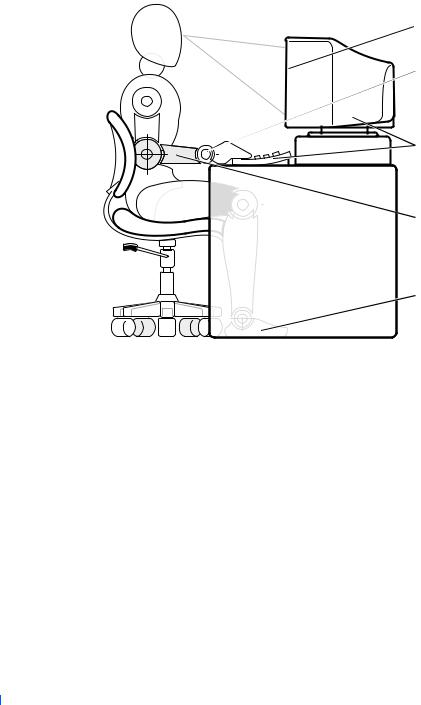
w w w . d e l l . c o m | s u p p o r t . d e l l . c o m
monitor screen at or below eye level
 wrists relaxed and flat
wrists relaxed and flat
 computer positioned directly in front of user
computer positioned directly in front of user
 arms at desk level
arms at desk level
 feet flat on the floor
feet flat on the floor
When Working Inside Your Computer
Before you open the computer cover, perform the following steps in the sequence indicated.
 CAUTION: Do not attempt to service the computer yourself, except as explained in this guide and elsewhere in Dell documentation. Always follow installation and service instructions closely.
CAUTION: Do not attempt to service the computer yourself, except as explained in this guide and elsewhere in Dell documentation. Always follow installation and service instructions closely.
1Turn off the computer (see page 22).
2Turn off all devices.
12

3Ground yourself by touching an unpainted metal surface at the back of the computer before touching anything inside your computer.
While you work, periodically touch an unpainted metal surface on the computer to dissipate any static electricity that might harm internal components.
4Disconnect any devices connected to the computer, including the monitor, from their electrical outlets to reduce the potential for personal injury or shock. Also, disconnect any telephone or telecommunication lines from the computer.
5Disconnect the power cable to your computer, and then press the power button to ground the system board.
In addition, take note of these safety guidelines when appropriate:
•When you disconnect a cable, pull on its connector, not on the cable itself. As you pull connectors apart, keep them evenly aligned to avoid bending any pins. Also, before you connect a cable, make sure that both connectors are correctly oriented and aligned.
•Handle components and cards with care. Don’t touch the components on a card. Hold a card by its edges or by its metal bracket.
 CAUTION: There is a danger of a new battery exploding if it is incorrectly installed. Replace the battery only with the same or equivalent type recommended by the manufacturer. Discard used batteries according to the manufacturer’s instructions.
CAUTION: There is a danger of a new battery exploding if it is incorrectly installed. Replace the battery only with the same or equivalent type recommended by the manufacturer. Discard used batteries according to the manufacturer’s instructions.
Protecting Against Electrostatic Discharge
To prevent static damage, discharge static electricity from your body before you touch anything inside your computer and periodically while you work inside the computer. You can do so by touching an unpainted metal surface on the back of the computer.
You can also take the following steps to prevent static damage:
•Do not remove items from their antistatic packing material until you are ready to install them in your computer. Just before unwrapping the antistatic packaging, be sure to discharge static electricity from your body.
•When transporting a sensitive component, first place it in an antistatic container or packaging.
13

w w w . d e l l . c o m | s u p p o r t . d e l l . c o m
14

S E C T I O N 1
Attaching and Removing the Computer Stand
Connecting a Printer
Transferring Information to a New Computer (Windows XP only)
Setting Up a Home and Office Network
(Windows XP only)
Turning Off the Computer
m o c . l l e d . t r o p p u s | m o c . l l e d .w w w
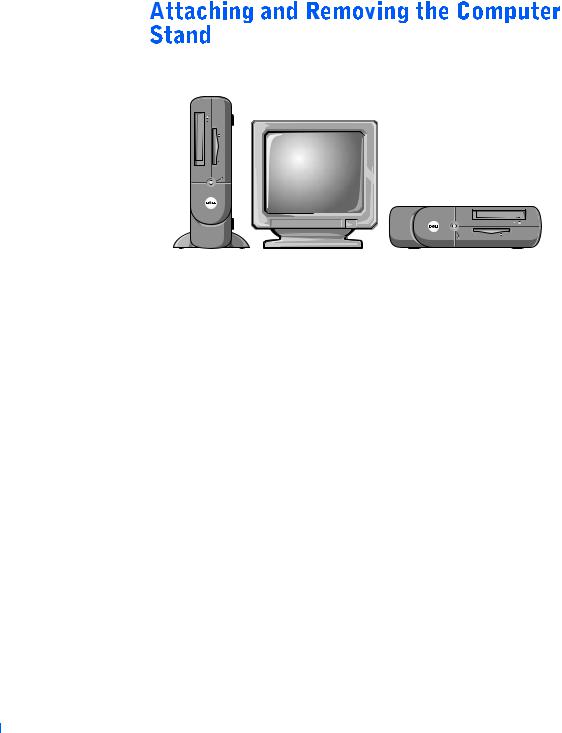
w w w . d e l l . c o m | s u p p o r t . d e l l . c o m
The computer can be used in either a vertical or horizontal position.
To use the computer in a vertical position, you must attach the computer stand:
1Place the computer on its right side so that the drive bays are at the bottom.
16 Setting Up
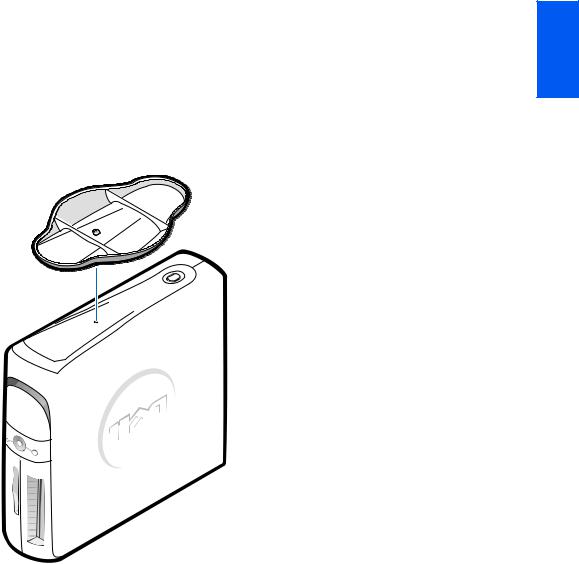
2Fit the stand onto what was the left side of the computer.
a Position the stand as shown in the following illustration by aligning the large round hole in the stand with the securing button on the side of the cover and aligning the captive screw in the stand with the screw hole in the cover.
b When the stand is in place, tighten the thumbscrew.
3Rotate the computer so that the stand is at the bottom and the drives
are at the top.
Setting Up |
|
17 |
|

w w w . d e l l . c o m | s u p p o r t . d e l l . c o m
To remove the computer stand:
1Turn the computer over so that the stand is at the top.
2Loosen the thumbscrew and lift the stand away.
3Place the computer in a horizontal position.
See the documentation that came with the printer for any recommended preparation procedures, such as:
•Removing the packaging
•Installing the toner or ink cartridge
•Loading paper
Then follow the instructions that came with the printer to connect it to the computer. If no information is provided, see the following sections.
Parallel Printer
1 Turn off the computer (see page 22).
NOTICE: Use only a standard IEEE parallel cable measuring 3 m (10 ft) or less to connect the printer to the computer. Use of a nonstandard cable may prevent the printer from working.
18 Setting Up
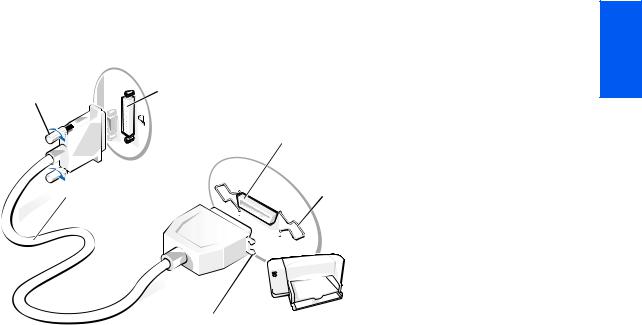
2Attach the parallel printer cable to the parallel connector on the computer and tighten the two screws. Attach the cable to the parallel connector on the printer and snap the two clips into the two notches.
|
parallel connector |
screws (2) |
on computer |
parallel connector on printer
parallel printer |
clips (2) |
cable |
|
notches (2)
3Turn on the printer and then turn on the computer. If the Add New Hardware Wizard window appears, click Cancel.
4Install the printer driver if necessary (see "Installing the Printer Driver" on page 20).
Setting Up |
|
19 |
|
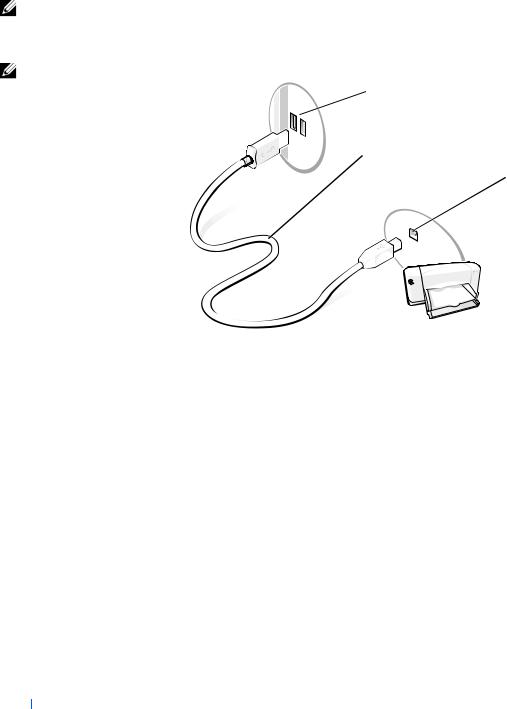
w w w . d e l l . c o m | s u p p o r t . d e l l . c o m
HINT: You can connect USB devices while the computer is turned on.
HINT: Your computer has two USB connectors on the back panel (see
page 61) and two USB connectors inside the door on the front panel (see page 60).
USB Printer
1Install the printer driver if necessary (see the following section).
2Attach the USB printer cable to the USB connector on the computer and the printer. The USB connectors only fit one way.
USB connector
USB printer
cable USB connector on printer
Installing the Printer Driver
If you need to install a printer driver, insert the printer installation CD into the CD or DVD drive. Then follow the prompts on the screen using the instructions that came with the printer.
If your printer installation CD does not automatically run, click the Start button on the Microsoft® Windows® desktop, click Run, and type x:\setup.exe (where x is the letter of your CD or DVD drive [usually drive D]). Then click OK and follow the prompts on your screen. If your printer installation CD still does not run, check the documentation that came with your printer for instructions on how to start the printer installation CD.
If you connect an older printer and it doesn’t work after you install the driver, access the system setup program (see page 78) and ensure that the parallel port is set to operate in bidirectional mode.
20 Setting Up
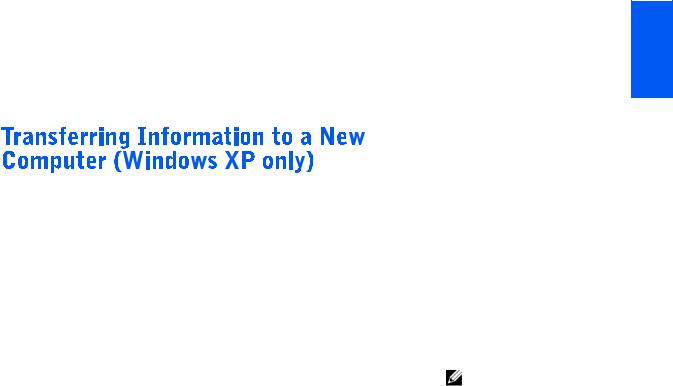
To check if your printer driver is installed on a computer running the Windows XP operating system, click the Start button, click Control Panel, click Printers and Other Hardware, and then click View installed printers or fax printers. If your computer runs Windows 2000, click the Start button, point to Settings, and then click Printers. If your printer is listed in the Printers window, the printer is ready to use.
Windows XP provides a Files and Settings Transfer Wizard to move data, such as e-mails, window sizes, toolbar settings, and Internet bookmarks, from one computer to another. First you collect the data from the source computer, and then you import the data to the new computer.
If the source computer uses another Windows operating system, the wizard can be launched from the Windows XP operating system CD or from a floppy disk created on the Windows XP computer. You may transfer the data to the new computer over a network or serial connection, or you may store it on a removable medium, such as a floppy disk, a Zip disk, or a writable CD.
1On the Windows XP computer, click the Start button, point to All Programs—> Accessories—> System Tools, and then click Files and Settings Transfer Wizard.
2On the welcome screen, click Next.
3On the Which computer is this? screen, select New Computer, and then click Next.
4Follow the instructions on the screen.
HINT: The CD that you need to place in your CD or DVD drive is titled
Operating System.
Setting Up |
|
21 |
|
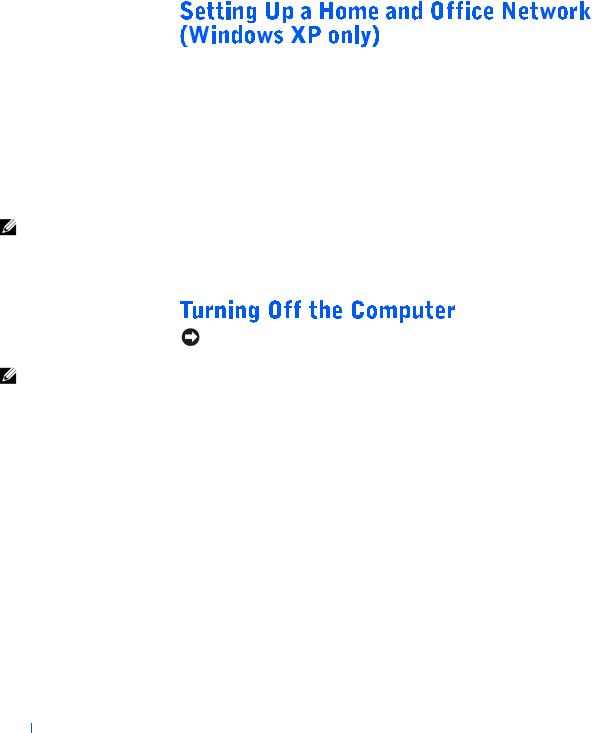
w w w . d e l l . c o m | s u p p o r t . d e l l . c o m
HINT: Selecting the connection method This computer connects directly to the Internet enables the integrated firewall provided with Windows XP.
HINT: If you are having difficulty turning off your computer, see "General Program Problems” on page 43.
Windows XP provides a Network Setup Wizard to guide you through the process of sharing files, printers, or an Internet connection between computers in a home or small office.
1Click the Start button, point to All Programs—> Accessories—> Communications, and then click Network Setup Wizard.
2On the welcome screen, click Next.
3Click checklist for creating a network.
4Complete the checklist and required preparations, and then return to the Network Setup Wizard.
5Follow the instructions on the screen.
NOTICE: To prevent data loss, you must turn off your computer through the Start menu rather than by pressing the power button.
Windows XP
1Save and close any open files and exit any open programs.
2Click the Start button and then click Turn off Computer.
3Click Turn off.
The computer automatically turns off after the shutdown process finishes.
4Turn off your monitor and any other devices connected to power.
Windows 2000
1Save and exit any programs and files you have open.
2Click the Start button, and then click Shut Down.
3Click the pull-down menu under What do you want the computer to do?.
22 Setting Up

4Click Shut down and then click OK.
The computer automatically turns off after the shutdown process finishes.
5Turn off your monitor and any other devices connected to power.
Setting Up |
|
23 |
|

w w w . d e l l . c o m | s u p p o r t . d e l l . c o m
Up Setting 24

S E C T I O N 2
Finding Solutions
Accessing Help Files
Power Problems
Start-Up Error Messages
Video and Monitor Problems
Sound and Speaker Problems
Printer Problems
Scanner Problems
Modem Problems
Mouse Problems
Keyboard Problems
Drive Problems
Network Problems
Microsoft® Windows® Error Messages
General Program Problems
Internet Connection Problems
E-Mail Problems
Resolving Other Technical Problems
Reinstalling Drivers
Resolving Software and Hardware Incompatibilities
Using System Restore
Reinstalling Windows XP
Reinstalling Windows 2000
m o c . l l e d . t r o p p u s | m o c . l l e d .w w w
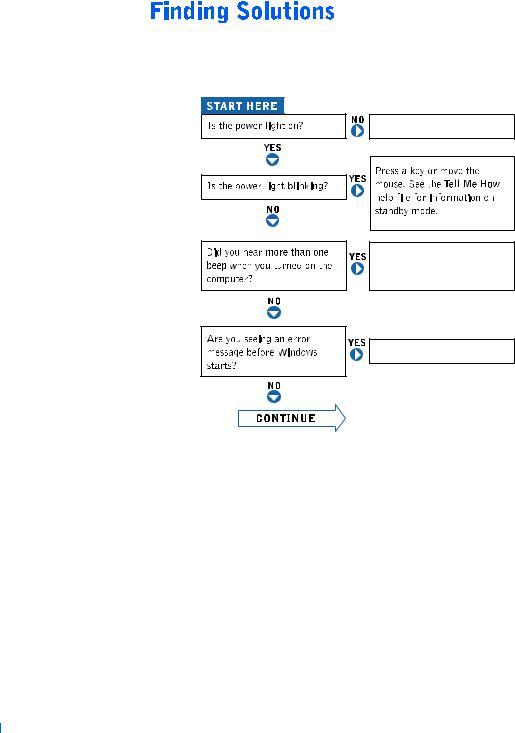
w w w . d e l l . c o m | s u p p o r t . d e l l . c o m
Sometimes it’s difficult to figure out where to go for answers. Use this chart to help you quickly find the answers to your questions.
See page 28.
Get technical assistance from
Dell. See page 84.
See page 29.
26 Solving Problems
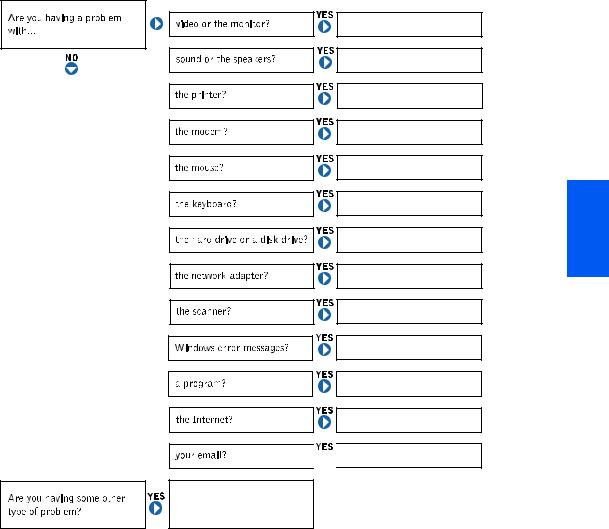
See page 30.
See page 32.
See page 33.
See page 36.
See page 37.
See page 38.
See page 39.
See page 42.
See page 35.
See page 42.
See page 43.
See page 45.


 See page 46.
See page 46.
See page 47.
Solving Problems |
|
27 |
|
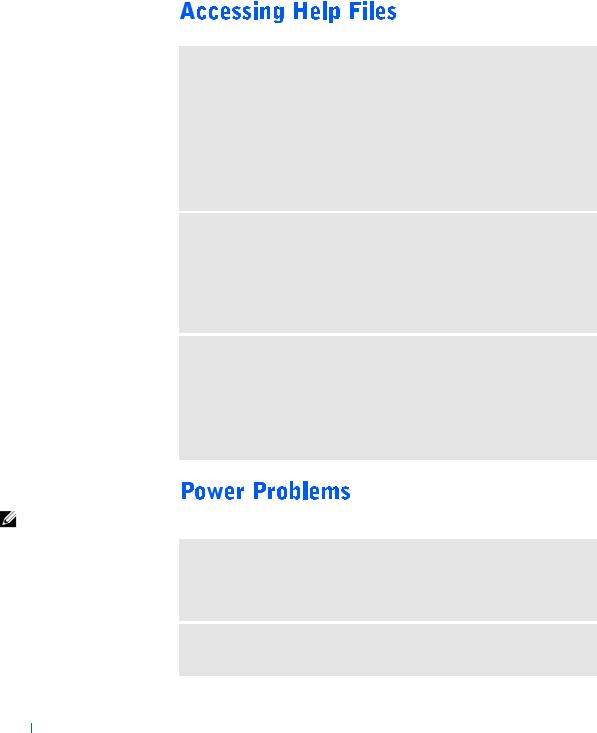
w w w . d e l l . c o m | s u p p o r t . d e l l . c o m
HINT: See the Tell Me How help file for information on the standby mode.
TO ACCESS THE Tell Me How HELP FILE
Microsoft® Windows® XP
1 Click the Start button, and then click Help and Support.
2 Click User and system guides, and then click User’s guides. 3 Click Tell Me How.
Windows 2000
Click the Start button, point to Programs, point to User’s Guides, and then click
Tell Me How.
TO ACCESS HELP IN WINDOWS XP
1 Click the Start button, and then click Help and Support.
2 Type a word or phrase that describes your problem, and then click the arrow icon.
3 Click the topic that describes your problem, and then click Display. 4 Follow the instructions shown on the screen.
TO ACCESS HELP IN WINDOWS 2000
1 Click the Start button, and then click Help. 2 Click the Search tab.
3 Type a word or phrase that describes your problem, and then click List Topics. 4 Click the topic that describes your problem, and then click Display.
5 Follow the instructions shown on the screen.
CHECK THE POWER LIGHT— When the power light is lit or blinking, the computer has power. If the power light is blinking, the computer is in standby mode—press a key on the keyboard or move the mouse. If the power light is off, the computer is either not turned on or is not receiving electrical power.
TEST THE ELECTRICAL OUTLET— Ensure that the electrical outlet is working by testing it with another device, such as a lamp.
28 Solving Problems

CHECK THE POWER CABLE CONNECTION— Be sure that the power cable is firmly inserted into the electrical outlet and the computer power connector.
CONNECT THE COMPUTER DIRECTLY TO AN ELECTRICAL OUTLET—
Bypass power protection devices, power strips, and the extension cable to verify that the computer turns on.
SWAP THE COMPUTER AND MONITOR POWER CABLES— Swap the computer and monitor power cables to determine if the power cable is defective.
CHECK FOR INTER FERENCE— Electrical appliances on the same circuit or operating near the computer can cause interference. Other causes of interference: power extension cables, keyboard and mouse extension cables, too many devices on a power strip, or multiple power strips connected to the same electrical outlet.
CHECK THE POWER PROPERTIES— See the Tell Me How help file or search for the keyword standby in Windows Help. To access help files, see page 28.
OPERATING SYSTEM NOT FOUND— Call Dell for technical assistance (see page 84).
INSERT BOOTABLE MEDIA— The operating system is trying to boot to a nonbootable floppy disk or CD. Insert a bootable floppy disk or CD.
NON-SYSTEM DISK ERROR— There is a floppy disk in the floppy drive. Remove the floppy disk and restart the computer.
Solving Problems |
|
29 |
|
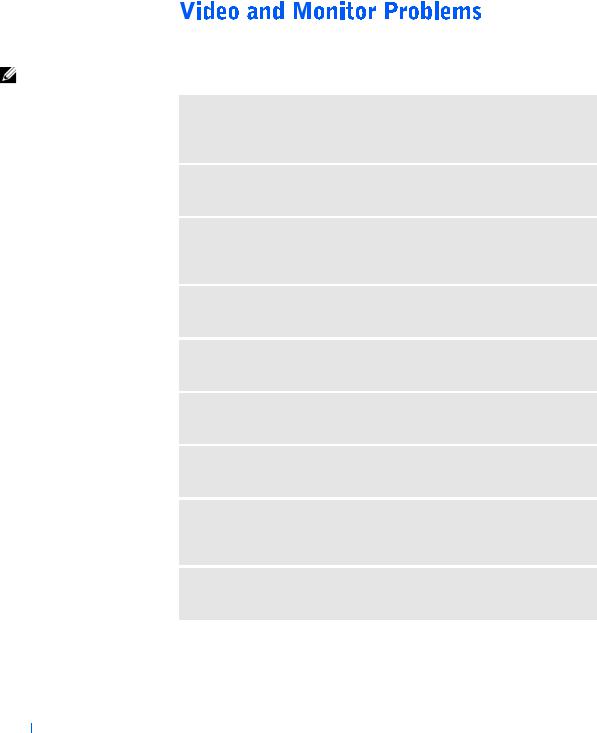
w w w . d e l l . c o m | s u p p o r t . d e l l . c o m
HINT: See the documentation that come with your monitor for fault indications and troubleshooting procedures specific to your monitor.
If the screen is blank
CHECK THE VIDEO CABLE CONNECTION— Check for bent pins (most video cable connectors have missing pins, but not bent pins). Ensure that the video cable is connected as shown on the START HERE sheet for your computer.
PRESS THE MONITOR POWER BUTTON— Be sure that you firmly pressed the monitor power button.
CHECK THE POWER LIGHT— When the power light is lit or blinking, the monitor has power. If the power light is blinking, press a key on the keyboard or move the mouse.
TEST THE ELECTRICAL OUTLET— Ensure that the electrical outlet is working by testing it with another device, such as a lamp.
SWAP THE COMPUTER AND MONITOR POWER CABLES— Swap the computer and monitor power cables to determine if the power cable is defective.
TEST THE VIDEO EXTENSION CABLE (IF USED)— If you are using a video extension cable and removing the cable solves the problem, the cable is defective.
TEST THE MONITOR— If another monitor is available, connect it to the computer.
CHECK THE BACK PANEL LIGHTS— If all four lights below the serial connector (see page 61) are not green, call Dell for technical assistance (see page 84).
CHECK THE POWER PROPERTIES— See the Tell Me How help file or search for the keyword standby in Windows Help. To access help files, see page 28.
30 Solving Problems
